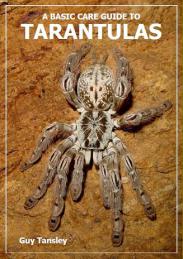
The arboreal genus of Psalmopoeus Pocock, 1895 consists
of 11 described species but only 4 are commonly found in captivity. All are arboreal in nature and require a standard arboreal set-up. Most readily breed in captivity therefore specimens of all sizes
should be readily available.
Common species in captivity:
P.
cambridgei Pocock, 1895 - Trinidad
Although it can be temperamental, P. cambridgei is an ideal first arboreal species being hardy and fairly easy to rear. Colouration is various shades of green and brown with characteristic red/orange flashes down the metatarsi and
tarsi. A large, fast growing species that reaches 15 cms in legspan and an active feeder, they make good display animals being fairly active given the correct housing environment. Standard arboreal
set-up is ideal (cork bark slab, slightly moist substrate and good ventilation), see here for more info on housing. Breeds freely in captivity, the male being a more uniform grey/brown colour. Two eggsacs are commonly produced from one pairing and these often
contain 100 - 150 spiderlings. Captive bred stock should therefore always be available at a reasonable price.
P. irminia Saager, 1994 - Venezuela
Similar in size and temperament to P. cambridgei, P. irminia is a fairly easy species to rear. More strikingly marked
than P. cambridgei with black, yellow and vivid red stripes down the metatarsus and abdomen. Good
feeders, they can grow rapidly to a large size, some individuals reaching 7" in legspan. Males can be ever larger but more drab in colour but with similar metatarsus leg markings like the female.
Mating is straight forward with a receptive female and she will respond eagerly with eager drumming. Actual mating is brief but courtship can be quite long, the male making sure she's in just the
right position before mating. Males usually escape unharmed as the female remains quite calm throughout. Several males can be used in succession with receptive females. An eggsac is produced some 8 -
12 weeks later with a further 8 - 12 weeks incubation before the spiderlings emerge and eggsacs typically contain 150 - 200 young. P.
irminia is known to sometimes produce infertile eggsacs without being mated. Relatively new to the hobby and only recently described (1994), this is a
stunning species and a great addition to any collection. Should be available as captive bred spiderlings due to it's ease of breeding in captivity. Typical arboreal set-up is ideal, moist compost
substrate, large piece of cork bark against rear of the tank providing retreat.
P.
pulcher Petrunkevitch, 1925 - Panama
Commonly called the Panama blonde due to it's colouration - blonde hairs cover the spider in adults whereas spiderlings and juveniles the abdomen is contrasting coloured black. This fades as the
spider matures. A medium sized species (up to 12 cms legspan) and slightly nervous, it will often fill it's container with thick silk and remain hidden for most of the time. Not as available as
others in the genus but captive breeding is slowly changing this.
P.
reduncus (Karsch, 1880) - Costa Rica
One of the smallest in the genus (up to 10 cms legspan) and coloured light to dark brown overall. A typical arboreal set-up is recommended but with slightly deeper substrate as this one will often
burrow somewhat.

